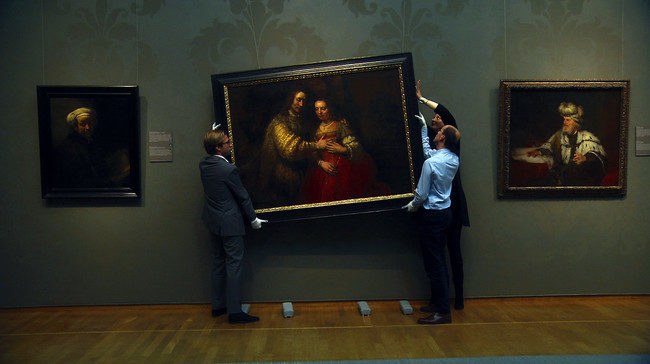Contentious museum redesigns have become commonplace lately, from Diller Scofidio + Renfro's plans for the Museum of Modern Art in New York, to Peter Zumthor's divisive proposal for a new LACMA superstructure. But as the documentary The New Rijksmuseum: Years of Metamorphosis shows, it's not a problem confined to the United States.
The film, which opened in Los Angeles June 19, tracks the decade-long renovation of Amsterdam's Rijksmuseum in almost excruciating detail. Begun in 2003, the project intended to bring Pierre Cuypers' 1885 building up to 21st century "museological" standards.
Seville and Amsterdam-based architects Antonio Cruz and Antonio Ortiz's original plan called for updating galleries and creating a new entrance for museumgoers by rethinking an outdoor passageway that splits the Rijksmuseum building. The proposal would give the central roadway to foot traffic and a museum entrance, while diverting bicycle traffic to the edges of the passage.
Naturally, bike riders raged. Amsterdam's Cyclist Union mounted a vigorous campaign in public hearings against the passageway plan. The cyclists won, which brought the entire renovation to a grinding halt. "It's all being decided at cobblestone level,” exclaims museum director Wim Pijbes after another Union protest.
Director Oeke Hoogendijk had seemingly unfettered access to the entire process. Her cameras are inside the Rijksmuseum as construction begins; they're in closed-door meetings with interior designer Jean-Michel Wilmotte (at one point even catching him nodding off); they preserve every false start, every moment of celebration-turned-exasperation-turned-resignation-turned-relief from museum staff and architects. The result is perhaps the most exacting cinematic document of a museum renovation.
And yet, at points it feels incomplete. The New Rijksmuseum began as a four-hour, four-part television series, and then was cut to a 132-minute theatrical version. While this abridgment hits all the beats, from the start of the project to its merciful completion in 2013, too much seems to have been left out.
Hoogendijk sets up multiple conflicts, like with the Cyclists Union and Wilmotte, which see resolution. But there are other, more bureaucratic issues that are introduced and then, magically, resolved. For example, a contractor’s bid on the renovation comes in at €238 million, well above the project’s budget of €134 million. The reality of the bid slaps the project manager in his impressively mustachioed face: he’s left wondering — as are we — where the project goes from here. Does the government pony up more money? Do they go with a different contractor? Something happens because the renovation moves along, but we're never given the resolution.
In the final accounting, the lack of resolution doesn't sabotage the documentary, but it’s frustrating in a work that spends so much time on moments that have little narrative utility. The film begins with nearly three minutes of exquisite construction scenes from inside the Rijksmuseum followed by a prolonged aerial shot of the building at dusk. Later, Hoogendijk luxuriates on moments of art conservation and images of light penetrating the hollowed out museum. While beautiful, such scenes stop the film cold.
Then there's the strange undercurrent of militarism. Before the opening construction sequence, we hear the distant sounds of jackhammers. But if you didn’t know any better you’d swear it was machine gun fire. Later in the film, frustrated with the Cyclists Union's intransigence, Ortiz sighs, "This is not how democracy works." When it's finally time to restage the museum's collection, Pijbes calls it a "military-style operation,” which is said over a street-level shot of rolling construction equipment treads meant to evoke a tank. These moments speak to a broader, rebuilding-museums-is-war argument on the part of Hoogendijk that's unfortunately never fully developed.
None of that is to say The New Rijksmuseum is a bad film. On the contrary, it's a valuable record of this byzantine process, and Hoogendijk's dedication to documenting anything and everything gives it a depth that's rare for a work like this. But the documentary fails in the edit; the film’s pacing is so off, and its attention pulled in so many directions, that it feels simultaneously rushed and laborious, sometimes to the point of tedium.
Maybe, though, that's the only way a project the scale of a museum renovation can be represented on film — in starts and stops, with sidelines into exasperating dead ends, and brief respites among the art and beauty caught in the crossfire of organizational agendas and personal legacies.
The New Rijksmuseum opened in Los Angeles June 19, then moves to other cities throughout the summer and fall. A complete list of playdates can be found on the film's website.







